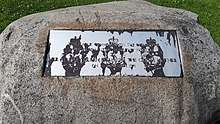Shrapnel Barracks
The Shrapnel Barracks was a British army base providing living accommodation in Woolwich in southeast London from the mid-19th century until the 1960s. Named after Lieutenant General Henry Shrapnel (who invented the shrapnel shell and was for some years based at the nearby Royal Arsenal), it was situated to the northwest of the modern-day Stadium Road, on the western edge of Woolwich Common; the site is now occupied by the Queen Elizabeth Hospital.
| Shrapnel Barracks | |
|---|---|
| Woolwich | |
.jpg) | |
 Shrapnel Barracks Location within London | |
| Coordinates | 51.4789°N 0.0511°E |
| Type | Barracks |
| Site information | |
| Owner | Ministry of Defence |
| Operator | |
| Site history | |
| Built | c.1853 |
| In use | c.1853-c.1965 |
History
Early history
A "hutted camp" on the site "dating from the Crimea" (1853-1856) is recorded and was the base for cavalry units stationed in Woolwich, and later a field artillery brigade[1] (the Royal Artillery Barracks are nearby). A contemporary account describing the so-called "Duke of York's cottages" talked of hundreds of "mud huts" of which the Government grew ashamed and had them replaced, though they continued to be called "the Huts".[2] The camp was in place before 1869 as it is depicted on the Ordnance Survey 1st edition map of that date.[3] After an outbreak of diphtheria, the insanitary and overcrowded camp was replaced with more permanent dwellings in the late 1870s.[3][4]
Plans for the barracks dated 1897 and 1910 are held at the National Archives in Kew.[5][6]
In 1904, the barracks was the scene of a double tragedy in which a soldier shot his girlfriend and then himself.[7]
In 1942, during World War II, the barracks was the location of two heavy anti-aircraft guns,[8] helping protect areas of southeast London from enemy action. On 28 October 1944, a V-2 rocket exploded prematurely above the barracks without causing any casualties.[9] The barracks was used by the Royal Artillery and the Women's Royal Army Corps before demolition in the 1960s.[3]
Hospital site

The site was subsequently used for construction of the £16m Queen Elizabeth Military Hospital. A foundation stone was laid in 1972, with the hospital opening five years later,[10][11] and being officially opened on 1 November 1978. The hospital had 456 beds in 16 wards, and cared for servicemen and their families, Chelsea Pensioners and Far East Prisoner of War survivors, plus local civilians. It closed in 1995 following government defence cuts. In March 2001 it was reopened as the Queen Elizabeth Hospital, and was later (2006) rebuilt and extended, though some original features, such as the main entrance, remain.[12] The barracks name is recalled by a road, Shrapnel Close, skirting the western edge of part of the hospital site.[13]
Notable people connected with the barracks
Spike Milligan's father Leo joined the army as a boy soldier in the Royal Artillery at Shrapnel Barracks in 1904,[14] while journalist Bill Deedes was stationed there briefly in 1940.[15] Terence Thomas, Baron Thomas of Macclesfield was also stationed at the Shrapnel Barracks, in the 1950s.[16]
References
- "Summer meeting (June 2007): Woolwich: Home of the Royal Artillery 1716-2007". Royal Artillery Historical Society. RAHS. Retrieved 8 November 2017.
- Grover, Lieut G. E. (c.1870), "Historical Notes on the Royal Arsenal at Woolwich". Minutes of Proceedings of the Royal Artillery Institution
- Newsome, Sarah; Williams, Andrew (2009). An Archaeological Survey of Woolwich Common. English Heritage. Retrieved 8 November 2017.
- Guillery, Peter; Saint, Andrew (2012). Survey of London: Ch. 10: Woolwich Common and Royal Military Academy Areas. English Heritage. ISBN 9780300187229. Retrieved 8 November 2017.
- "Woolwich: plans and section of Shrapnel Barracks". The National Archives. Retrieved 8 November 2017.
- "Woolwich Barracks: Cavalry Depot, Shrapnel Barracks. Officers' mess and quarters. Record..." The National Archives. Retrieved 8 November 2017.
- "Shot in Barracks". Past Papers: STAR, ISSUE 8156, 2 NOVEMBER 1904. Retrieved 8 November 2017.
- "The Tirpitz and other stories". WW2: People's War. BBC Southern Counties. 14 July 2005. Retrieved 8 November 2017.
- "The Time of the Rockets (13 September 2013)". Blitzwalkers. Retrieved 8 November 2017.
- "Queen Elizabeth Military Hospital QEMH Woolwich". Qaranc.co.uk. Retrieved 8 November 2017.
- "Unit History: Queen Elizabeth Military Hospital". Forces War Records. Retrieved 8 November 2017.
- "Queen Elizabeth Military Hospital". Lost Hospitals of London. Retrieved 8 November 2017.
- "Shrapnel Close". London Town. Retrieved 7 April 2018.
- Milligan, Spike (2012). Milligan's Meaning of Life: An Autobiography of Sorts. Penguin UK. ISBN 9780241955956.
- Deedes, William (2013). Words and Deedes: Selected Journalism 1931-2006. Pan MacMillan. p. 70. ISBN 9780330541121.
- "A Man of Integrity". Manchester Evening News. 19 April 2010. Retrieved 8 November 2017.